Air Humidity Characteristics in “Local Climate Zones” of Novi Sad (Serbia) Based on Long-Term Data
Abstract
:1. Introduction
- Analysis of humidity characteristics in LCZs of Novi Sad on annual, seasonal, and monthly level as well as during heat wave (HW) and cold wave (CW) period;
- Assessment of the influences of air temperature on humidity in LCZs of Novi Sad; and
- Discussion of the main findings and provision of major conclusions for future humidity studies in cities.
2. Study Area, Data, and Methods
2.1. Study Area
2.2. Data
- (i)
- Average hourly RH and Ta data from 14 stations that are part of the NSUNET (Figure 2). The stations are equipped with fully calibrated air temperature and relative humidity General Electric Measurement & Control Company’s ChipCap 2 sensors (precision and accuracy ±2%RH, ±0.3 °C, 14bit). Sensors are individually calibrated and tested by manufacturer, performing at ±2% from 20% to 80% RH (±3% over entire humidity range), usable without further calibration or temperature compensation. The sensors are placed in radiation protection screens [27,28].
- (ii)
- 7 h, 14 h, and 21 h measurements of air pressure, from the official meteorological station of the Republic Hydrometeorological Service of Serbia (RHMZ) (Figure 2). Air pressure (in mb) data were used for the calculation of Q.
2.3. Methods
- LCZ A represents the zone with dense trees on a local scale, where evapotranspiration rate is higher than in other urban LCZs in Novi Sad; and
- LCZ A can also be considered as a natural (rural) LCZ in the vicinity of Novi Sad.
3. Results and Discussion
3.1. Annual Variations in Air Temperature and Air Humidity Parameters (RH, VPD, Q, AH, Ea) among LCZs
3.2. Seasonal Variations of Air Humidity Parameters (RH, Ea, Q, VPD, AH)
3.3. Monthly Dynamics of Air Temperature and Humidity Parameters (RH, VPD, Q, AH, Ea)
3.4. Daily and Hourly Differences during HW and CW
3.5. Relationship between Air Temperature and Humidity Parameters (RH, VPD, Q, Ea, and AH)
4. Conclusions
- (a)
- Air humidity patterns in urban areas relate to the level of urbanization. Therefore, the application of LCZ scheme is important for air humidity spatial dynamics, and could contribute to comparability of the results between different cities. The results show that UDI occurs in LCZ 2 from February to September. In other urban LCZs (5, 6, 8, and 9) this is not the case.
- (b)
- During the HW period, the air humidity dynamics show that UDII is most pronounced during the daytime, but also in the evening (approximately until midnight) in LCZ 2. However, lower intensity UDI is observed in the afternoon, in other urban LCZs (LCZ 6, LCZ 8, and LCZ 9) and occasionally in the later afternoon in LCZ 5.
- (c)
- All air humidity parameters are significantly correlated to air temperature dynamics.
Supplementary Materials
Author Contributions
Funding
Data Availability Statement
Acknowledgments
Conflicts of Interest
References
- Cuadrat, J.M.; Vicente-Serrano, S.M.; Saz, M.A.; Cuadrat, J.M. Influence of different factors on relative air humidity in Zaragoza, Spain. Front. Earth Sci. 2015, 3, 10. [Google Scholar] [CrossRef] [Green Version]
- Fortuniak, K.; Kłysik, K.; Wibig, J. Urban–rural contrasts of meteorological parameters in Łódź. Theor. Appl. Climatol. 2006, 84, 91–101. [Google Scholar] [CrossRef]
- Luo, M.; Lau, N.C. Urban Expansion and Drying Climate in an Urban Agglomeration of East China. Geophys. Res. Lett. 2019, 46, 6868–6877. [Google Scholar] [CrossRef]
- Yang, X.; Peng, L.L.; Chen, Y.; Yao, L.; Wang, Q. Air humidity characteristics of local climate zones: A three-year observational study in Nanjing. Build. Environ. 2020, 171, 106661. [Google Scholar] [CrossRef]
- Hage, K.D. Urban-Rural Humidity Differences. J. Appl. Meteorol. Climatol. 1975, 14, 1277–1283. [Google Scholar] [CrossRef]
- Epstein, Y.; Moran, D.S. Thermal Comfort and the Heat Stress Indices. Ind. Health 2006, 44, 388–398. [Google Scholar] [CrossRef] [PubMed] [Green Version]
- Geletič, J.; Lehnert, M.; Krč, P.; Resler, J.; Krayenhoff, E. High-Resolution Modelling of Thermal Exposure during a Hot Spell: A Case Study Using PALM-4U in Prague, Czech Republic. Atmosphere 2021, 12, 175. [Google Scholar] [CrossRef]
- Ibrahim, I.; Abu Samah, A.; Samah, A. Preliminary study of urban heat island: Measurement of ambient temperature and relative humidity in relation to landcover in Kuala Lumpur. In Proceedings of the 19th International Conference on Geoinformatics, Shanghai, China, 24–26 June 2011; pp. 1–5. [Google Scholar] [CrossRef]
- Hao, L.; Huang, X.; Qin, M.; Liu, Y.; Li, W.; Sun, G. Ecohydrological Processes Explain Urban Dry Island Effects in a Wet Region, Southern China. Water Resour. Res. 2018, 54, 6757–6771. [Google Scholar] [CrossRef]
- Oke, T.R.; Mills, G.; Christen, A.; Voogt, J.A. Urban Climates; Cambridge University Press: Cambridge, UK, 2017. [Google Scholar]
- Hilberg, S.D. Diurnal Temperature and Moisture Cycles. Summary of METROMEX, Vol. 2, Causes of Precipitation Anomalies. Illinois State Water Survey Bull 63. Urbana, 30–36. 1978. Available online: http://www.isws.illinois.edu/pubdoc/B/ISWSB-63.pdf (accessed on 10 June 2021).
- Lokoshchenko, M.A. Urban Heat Island and Urban Dry Island in Moscow and Their Centennial Changes. J. Appl. Meteorol. Climatol. 2017, 56, 2729–2745. [Google Scholar] [CrossRef]
- Yang, P.; Ren, G.; Hou, W. Temporal–Spatial Patterns of Relative Humidity and the Urban Dryness Island Effect in Beijing City. J. Appl. Meteorol. Climatol. 2017, 56, 2221–2237. [Google Scholar] [CrossRef]
- Ackerman, B. Climatology of Chicago Area Urban-Rural Differences in Humidity. J. Clim. Appl. Meteorol. 1987, 26, 427–430. [Google Scholar] [CrossRef]
- Lee, D.O. Urban-rural humidity differences in London. Int. J. Climatol. 1991, 11, 577–582. [Google Scholar] [CrossRef]
- Unkašević, M.; Jovanović, O.; Popović, T. Urban-suburban/rural vapour pressure and relative humidity differences at fixed hours over the area of Belgrade city. Theor. Appl. Climatol. 2001, 68, 67–73. [Google Scholar] [CrossRef]
- Robaa, S.M. Some aspects of the urban climates of Greater Cairo Region, Egypt. Int. J. Climatol. 2013, 33, 3206–3216. [Google Scholar] [CrossRef]
- Liu, W.; You, H.; Dou, J. Urban-rural humidity and temperature differences in the Beijing area. Theor. Appl. Climatol. 2009, 96, 201–207. [Google Scholar] [CrossRef]
- Masiero, E.; De Souza, L.C.L. Mapping humidity plume over local climate zones in a high-altitude tropical climate city, Brazil. Ambient. Constr. 2018, 18, 177–197. [Google Scholar] [CrossRef]
- Holmer, B.; Eliasson, I. Urban–rural vapour pressure differences and their role in the development of urban heat islands. Int. J. Climatol. 1999, 19, 989–1009. [Google Scholar] [CrossRef]
- Kuttler, W.; Weber, S.; Schonnefeld, J.; Hesselschwerdt, A. Urban/rural atmospheric water vapour pressure differences and urban moisture excess in Krefeld, Germany. Int. J. Climatol. 2007, 27, 2005–2015. [Google Scholar] [CrossRef]
- Unger, J.; Skarbit, N.; Gál, T. Absolute moisture content in mid-latitude urban canopy layer, Part 2: Results from Szeged, Hungary. Acta Climatol. 2018, 51–52, 47–56. [Google Scholar] [CrossRef]
- Anderson, V.; Leung, A.C.W.; Mehdipoor, H.; Jänicke, B.; Milošević, D.; Oliveira, A.; Manavvi, S.; Kabano, P.; Dzyuban, Y.; Aguilar, R.; et al. Technological opportunities for sensing of the health effects of weather and climate change: A state-of-the-art-review. Int. J. Biometeorol. 2021, 65, 779–803. [Google Scholar] [CrossRef]
- Geletič, J.; Lehnert, M.; Savić, S.; Milošević, D. Inter-/intra-zonal seasonal variability of the surface urban heat island based on local climate zones in three central European cities. Build. Environ. 2019, 156, 21–32. [Google Scholar] [CrossRef]
- Lehnert, M.; Savić, S.; Milošević, D.; Dunjić, J.; Geletič, J. Mapping Local Climate Zones and Their Applications in European Urban Environments: A Systematic Literature Review and Future Development Trends. ISPRS Int. J. Geo-Inf. 2021, 10, 260. [Google Scholar] [CrossRef]
- Savić, S.; Milošević, D.; Lazić, L.; Marković, V.; Arsenović, D.; Pavić, D. Classifying urban meteorological stations sites by’local climate zones’: Preliminary results for the city of Novi Sad (Serbia). Geogr. Pannonica 2013, 17, 60–68. [Google Scholar] [CrossRef] [Green Version]
- Šećerov, I.; Savić, S.; Milošević, D.; Marković, V.; Bajšanski, I. Development of an automated urban climate monitoring system in Novi Sad (Serbia). Geogr. Pannonica 2015, 19, 174–183. [Google Scholar] [CrossRef] [Green Version]
- Šećerov, I.B.; Savić, S.M.; Milošević, D.D.; Arsenović, D.M.; Dolinaj, D.M.; Popov, S.B. Progressing urban climate research using a high-density monitoring network system. Environ. Monit. Assess. 2019, 191, 89. [Google Scholar] [CrossRef] [PubMed]
- Lelovics, E.; Unger, J.; Gál, T.; Gál, C. Design of an urban monitoring network based on Local Climate Zone mapping and temperature pattern modelling. Climatol. Res. 2014, 60, 51–62. [Google Scholar] [CrossRef] [Green Version]
- Gál, T.; Skarbit, N.; Unger, J. Urban heat island patterns and their dynamics based on an urban climate measurement network. Hung. Geogr. Bull. 2016, 65, 105–116. [Google Scholar] [CrossRef] [Green Version]
- Skarbit, N.; Stewart, I.D.; Unger, J.; Gál, T. Employing an urban meteorological network to monitor air temperature conditions in the ‘local climate zones’ of Szeged, Hungary. Int. J. Climatol. 2017, 37, 582–596. [Google Scholar] [CrossRef]
- Chapman, L.; Muller, C.L.; Young, D.T.; Warren, E.L.; Grimmond, C.S.B.; Cai, X.-M.; Ferranti, E.J. The Birmingham Urban Climate Laboratory: An Open Meteorological Test Bed and Challenges of the Smart City. Bull. Am. Meteorol. Soc. 2014, 96, 1545–1560. [Google Scholar] [CrossRef]
- Bassett, R.; Cai, X.; Chapman, L.; Heaviside, C.; Thornes, J.E.; Muller, C.L.; Young, D.T.; Warren, E.L. Observations of urban heat island advection from a high-density monitoring network. Q. J. R. Meteorol. Soc. 2016, 142, 2434–2441. [Google Scholar] [CrossRef]
- Caluwaerts, S.; Hamdi, R.; Top, S.; Lauwaet, D.; Berckmans, J.; Degrauwe, D.; Dejonghe, H.; De Ridder, K.; De Troch, R.; Duchêne, F.; et al. The urban climate of Ghent, Belgium: A case study combining a high-accuracy monitoring network with numerical simulations. Urban Climatol. 2020, 31, 100565. [Google Scholar] [CrossRef]
- Richard, Y.; Emery, J.; Dudek, J.; Pergaud, J.; Chateau-Smith, C.; Zito, S.; Rega, M.; Vairet, T.; Castel, T.; Thévenin, T.; et al. How relevant are local climate zones and urban climate zones for urban climate research? Dijon (France) as a case study. Urban Climatol. 2018, 26, 258–274. [Google Scholar] [CrossRef] [Green Version]
- Unger, J.; Skarbit, N.; Gál, T. Absolute moisture content in mid-latitude urban canopy layer, Part 1: A literature review. Acta Climatol. 2018, 51–52, 37–45. [Google Scholar] [CrossRef] [Green Version]
- Kopp, J.; Frajer, J.; Novotná, M.; Preis, J.; Dolejš, M. Comparison of Ecohydrological and Climatological Zoning of the Cities: Case Study of the City of Pilsen. ISPRS Int. J. Geo-Inf. 2021, 10, 350. [Google Scholar] [CrossRef]
- Top, S.; Milošević, D.; Caluwaerts, S.; Hamdi, R.; Savić, S. Intra-urban differences of outdoor thermal comfort in Ghent on seasonal level and during record-breaking 2019 heat wave. Build. Environ. 2020, 185, 107103. [Google Scholar] [CrossRef]
- Christensen, J.; Hewitson, B.; Busuioc, A.; Chen, A.; Gao, X.; Held, I. Regional climate projection. Technical report. In Climate Change 2007: The Physical Science Basis. Contribution of Working Group I to the Fourth Assessment Report of the Intergovernmental Panel on Climate Change; Solomon, S., Qin, D., Manning, M., Chen, Z., Marquis, M., Averyt, K.B., Eds.; Cambridge University Press: Cambridge, UK; New York, NY, USA, 2007. [Google Scholar]
- Russo, S.; Sillmann, J.; Fischer, E.M. Top ten European heatwaves since 1950 and their occurrence in the coming decades. Environ. Res. Lett. 2015, 10, 124003. [Google Scholar] [CrossRef]
- Meehl, G.A.; Tebaldi, C. More Intense, More Frequent, and Longer Lasting Heat Waves in the 21st Century. Science 2004, 305, 994–997. [Google Scholar] [CrossRef] [Green Version]
- Kottek, M.; Grieser, J.; Beck, C.; Rudolf, B.; Rubel, F. World Map of the Köppen-Geiger climate classification updated. Meteorol. Z. 2006, 15, 259–263. [Google Scholar] [CrossRef]
- Stewart, I.D.; Oke, T.R. Local Climate Zones for Urban Temperature Studies. Bull. Am. Meteorol. Soc. 2012, 93, 1879–1900. [Google Scholar] [CrossRef]
- Milošević, D.; Savić, S.; Kresoja, M.; Lužanin, Z.; Šećerov, I.; Arsenović, D.; Dunjić, J.; Matzarakis, A. Analysis of air temperature dynamics in the “local climate zones” of Novi Sad (Serbia) based on long-term database from an urban meteorological network. Int. J. Biometeorol. 2021, 1–14. [Google Scholar] [CrossRef]
- Savic, S.; Geletic, J.; Milosevic, D.; Lehnert, M. Analysis of land surface temperatures in the “Local Climate Zones” of Novi Sad (Serbia). Glas. Srp. Geogr. Drus. 2020, 100, 41–50. [Google Scholar] [CrossRef]
- Savić, S.; Kalfayan, M.; Dolinaj, D. Precipitation spatial patterns in cities with different urbanisation types: Case study of Novi Sad (Serbia) as a medium-sized city. Geogr. Pannonica 2020, 24, 88–99. [Google Scholar] [CrossRef]
- Lelovics, E.; Unger, J.; Savić, S.; Gál, T.M.; Milošević, D.; Gulyás, Á.; Marković, V.; Arsenović, D.; Gál, C.V. Intra-urban temperature observations in two Central European cities: A summer study. Időjárás 2016, 120, 283–300. [Google Scholar]
- Bolton, D. The Computation of Equivalent Potential Temperature. Mon. Weather. Rev. 1980, 108, 1046–1053. [Google Scholar] [CrossRef] [Green Version]
- Vaisala. Humidity conversion formulas. In Calculation Formulas for Humidity; VaisalaOyj: Helsinki, Finland, 2014. [Google Scholar]
- Novick, K.A.; Ficklin, D.; Stoy, P.C.; Williams, C.A.; Bohrer, G.; Oishi, A.; Papuga, S.; Blanken, P.D.; Noormets, A.; Sulman, B.; et al. The increasing importance of atmospheric demand for ecosystem water and carbon fluxes. Nat. Climatol. Chang. 2016, 6, 1023–1027. [Google Scholar] [CrossRef] [Green Version]
- Pan, Y.; Birdsey, R.A.; Fang, J.; Houghton, R.; Kauppi, P.E.; Kurz, W.A.; Phillips, O.L.; Shvidenko, A.; Lewis, S.L.; Canadell, J.G.; et al. A Large and Persistent Carbon Sink in the World’s Forests. Science 2011, 333, 988–993. Available online: https://www.jstor.org/stable/27978486 (accessed on 6 June 2021). [CrossRef] [PubMed] [Green Version]
- Arya, P.S. Introduction to Micrometeorology; Elsevier: Amsterdam, The Netherlands, 2001. [Google Scholar]
- Montejo-Kovacevich, G.; Martin, S.H.; Meier, J.I.; Bacquet, C.N.; Monllor, M.; Jiggins, C.D.; Nadeau, N.J. Microclimate buffering and thermal tolerance across elevations in a tropical butterfly. J. Exp. Biol. 2020, 223, 220426. [Google Scholar] [CrossRef] [Green Version]
- Li, X.; Fan, W.; Wang, L.; Luo, M.; Yao, R.; Wang, S.; Wang, L. Effect of urban expansion on atmospheric humidity in Beijing-Tianjin-Hebei urban agglomeration. Sci. Total. Environ. 2021, 759, 144305. [Google Scholar] [CrossRef]
- Schlüter, S.; Kresoja, M. Two preprocessing algorithms for climate time series. J. Appl. Stat. 2019, 47, 1970–1989. [Google Scholar] [CrossRef]
- Mayer, H.; Matzarakis, A.; Iziomon, M.G. Spatio-temporal variability of moisture conditions within the Urban Canopy Layer. Theor. Appl. Climatol. 2003, 76, 165–179. [Google Scholar] [CrossRef]
- Fenner, D.; Meier, F.; Scherer, D.; Polze, A. Spatial and temporal air temperature variability in Berlin, Germany, during the years 2001–2010. Urban Climatol. 2014, 10, 308–331. [Google Scholar] [CrossRef]
- Vujović, D.; Todorović, N. Urban-rural fog differences in Belgrade area, Serbia. Theor. Appl. Climatol. 2018, 131, 889–898. [Google Scholar] [CrossRef]
- Song, Y.; Liu, Y.; Ding, Y. A study of surface humidity changes in china during the recent 50 years. Acta Meteorol. Sin. 2012, 26, 541–553. [Google Scholar] [CrossRef]
- Moriwaki, R.; Watanabe, K.; Morimoto, K. Urban Dry Island Phenomenon and Its Impact on Cloud Base Level. J. JSCE 2013, 1, 521–529. [Google Scholar] [CrossRef] [Green Version]
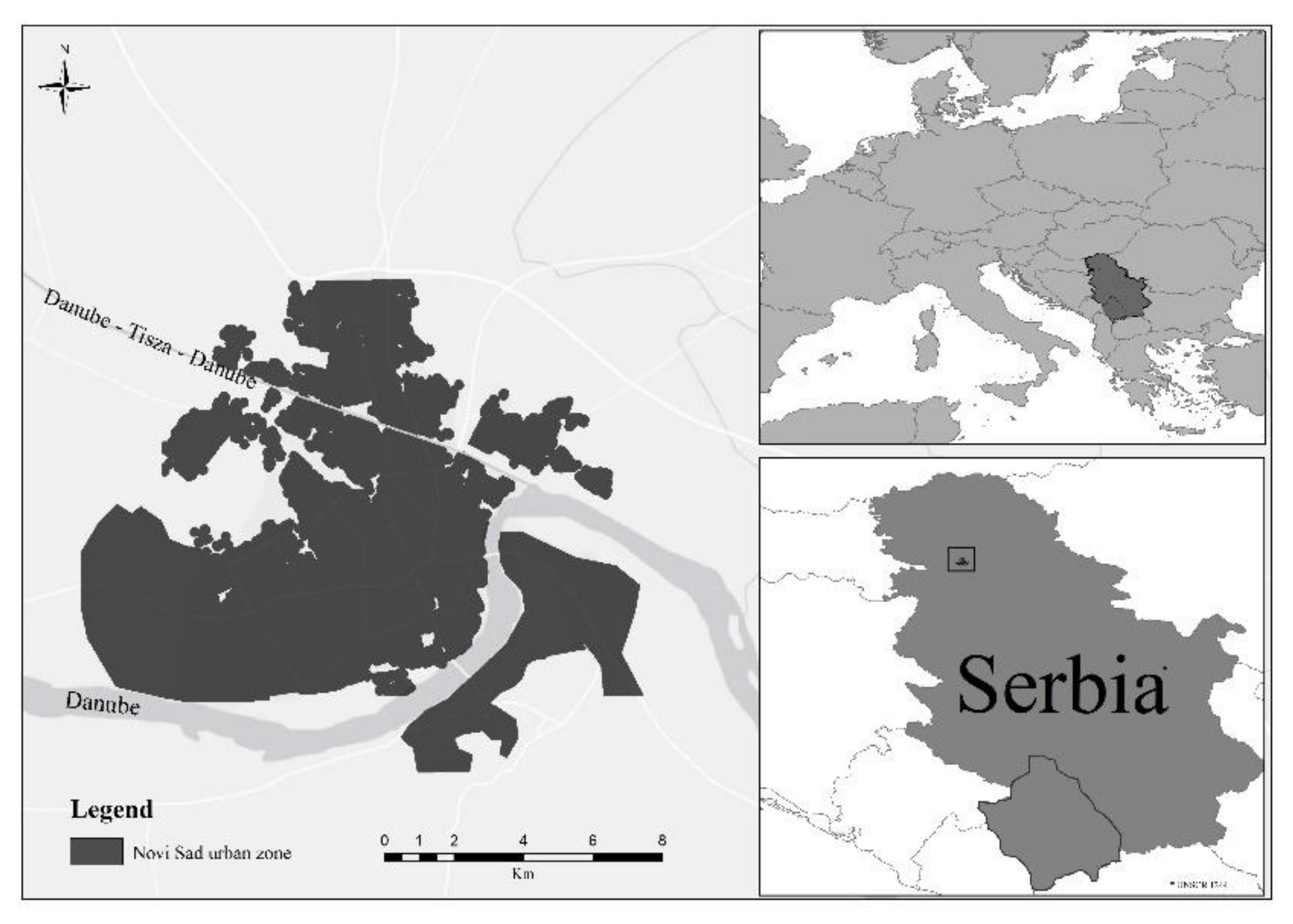
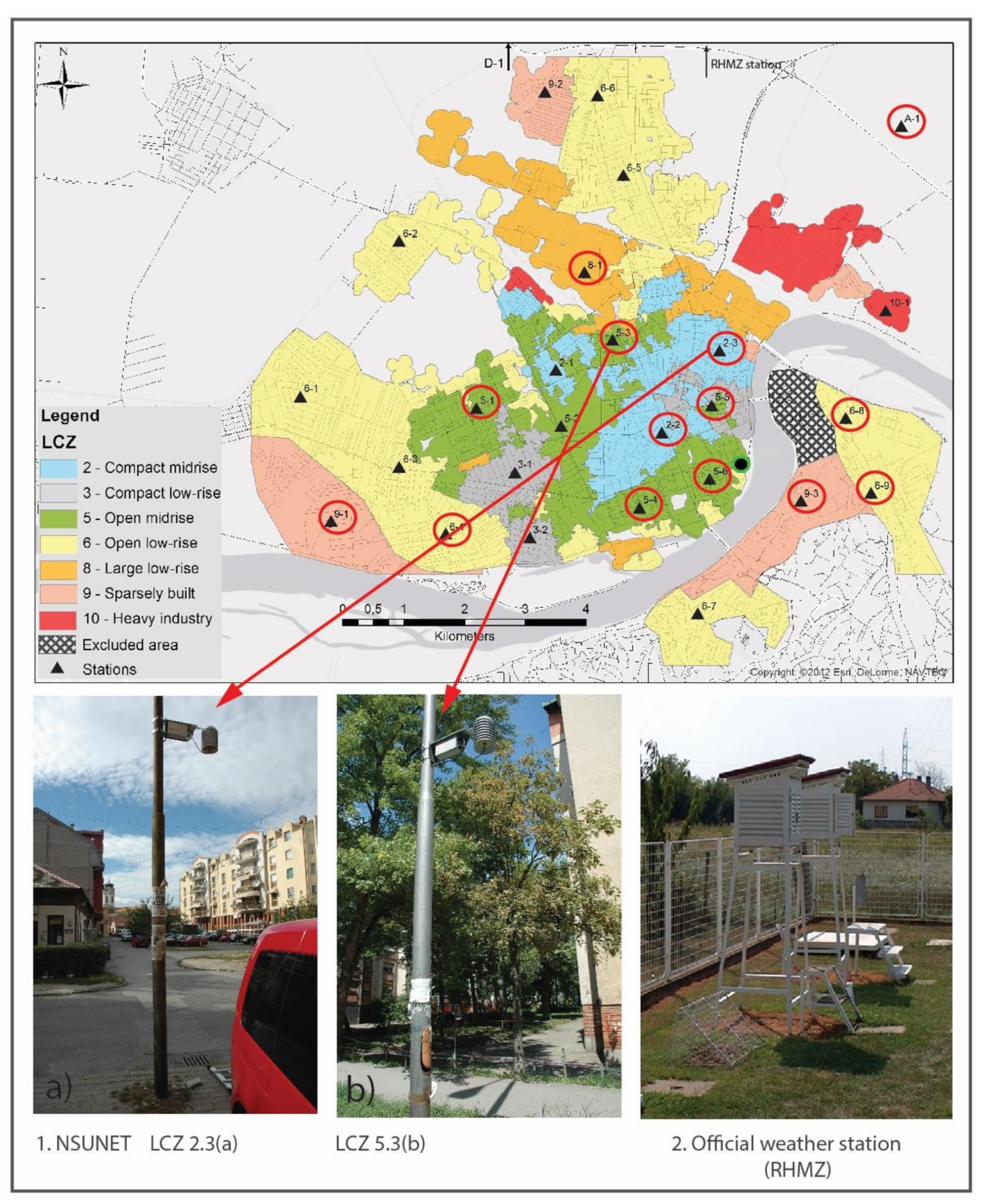
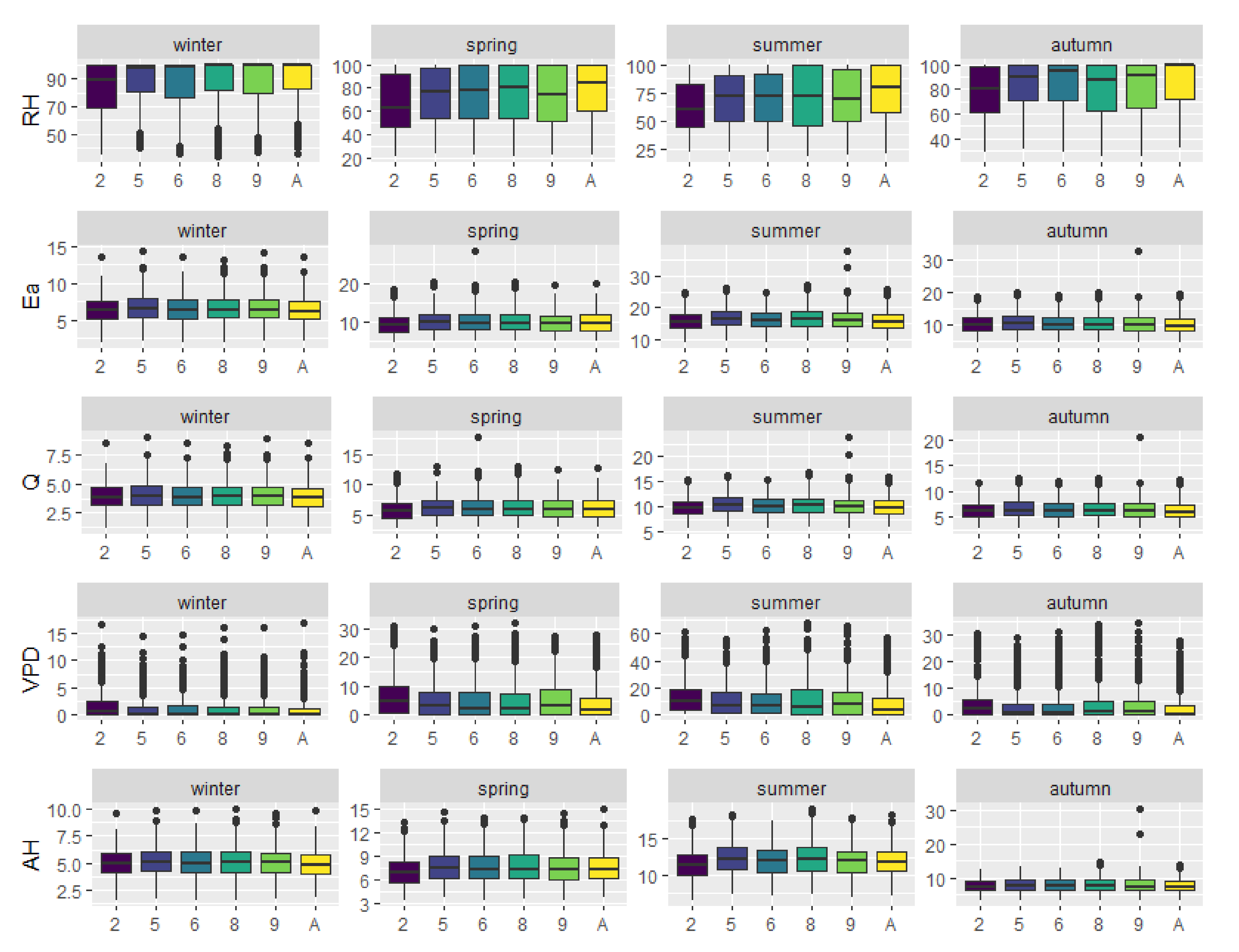
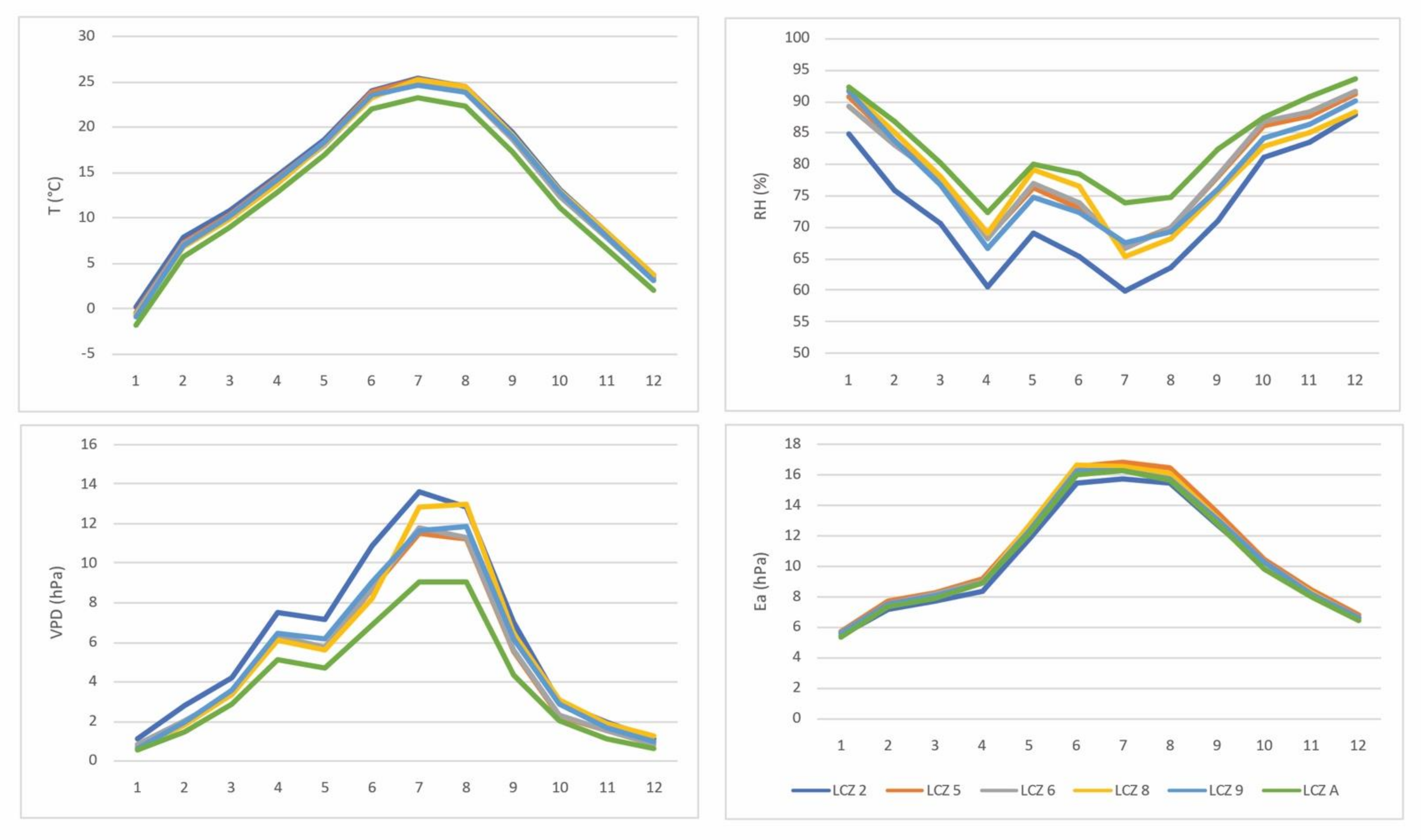
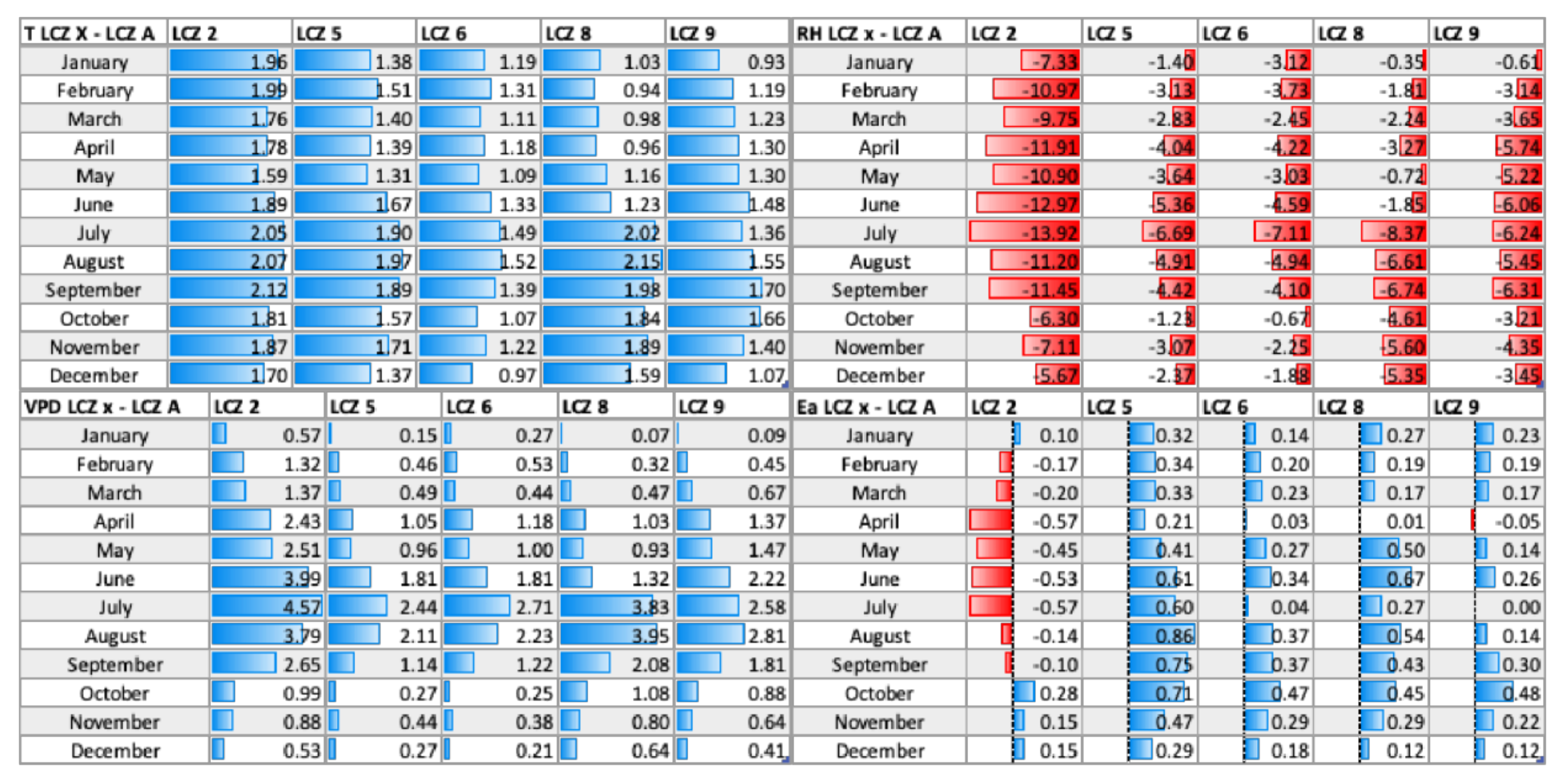

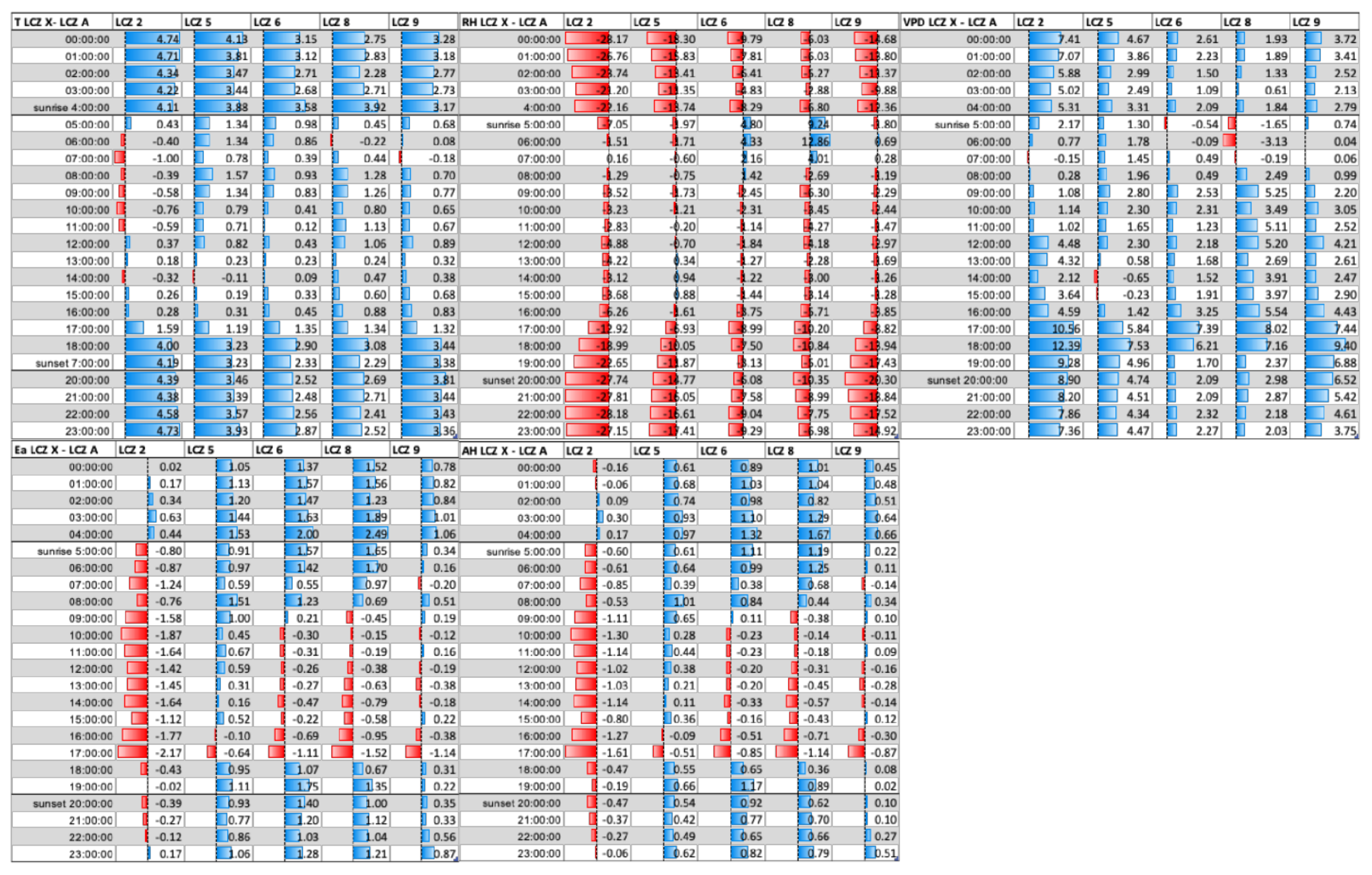
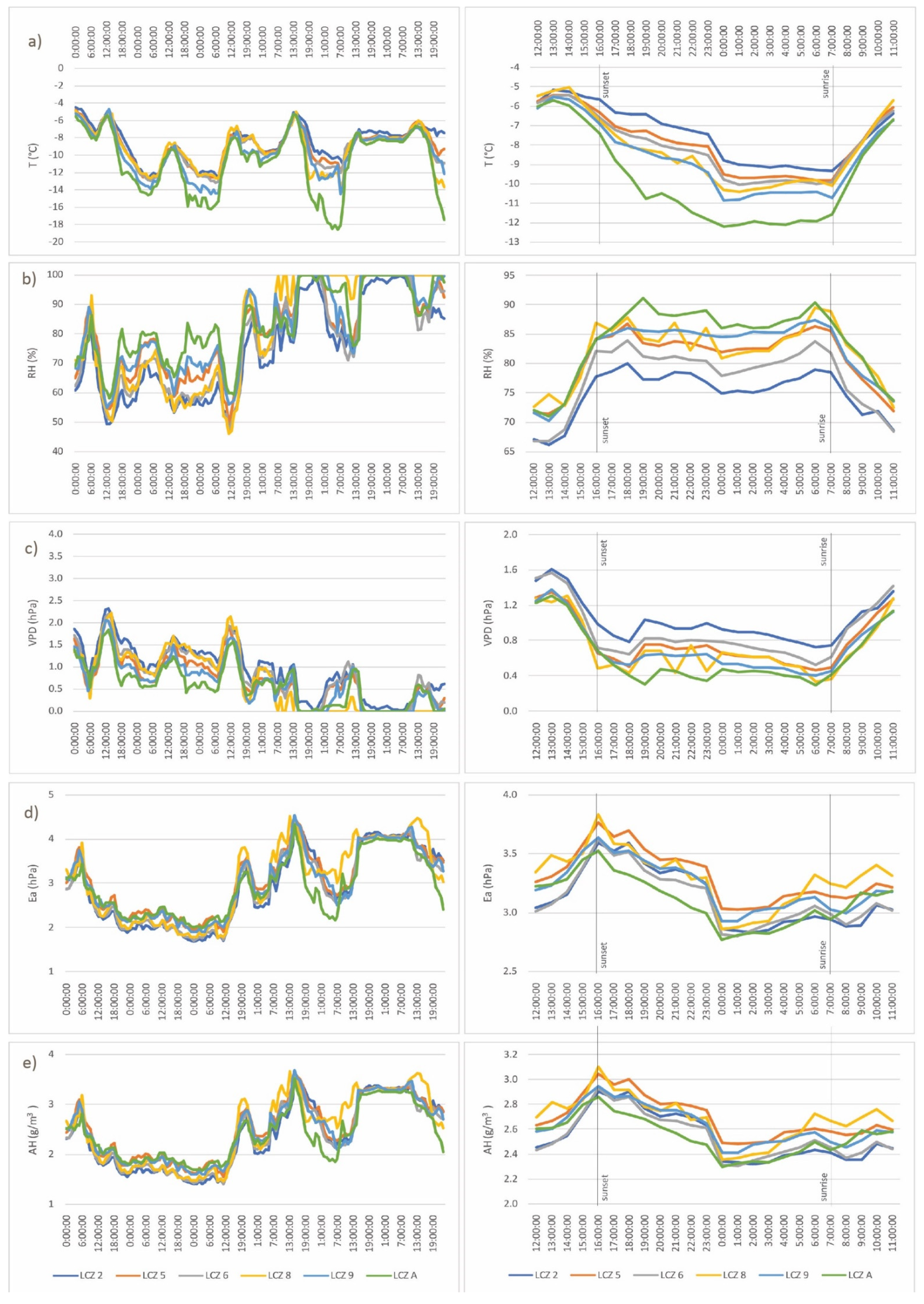
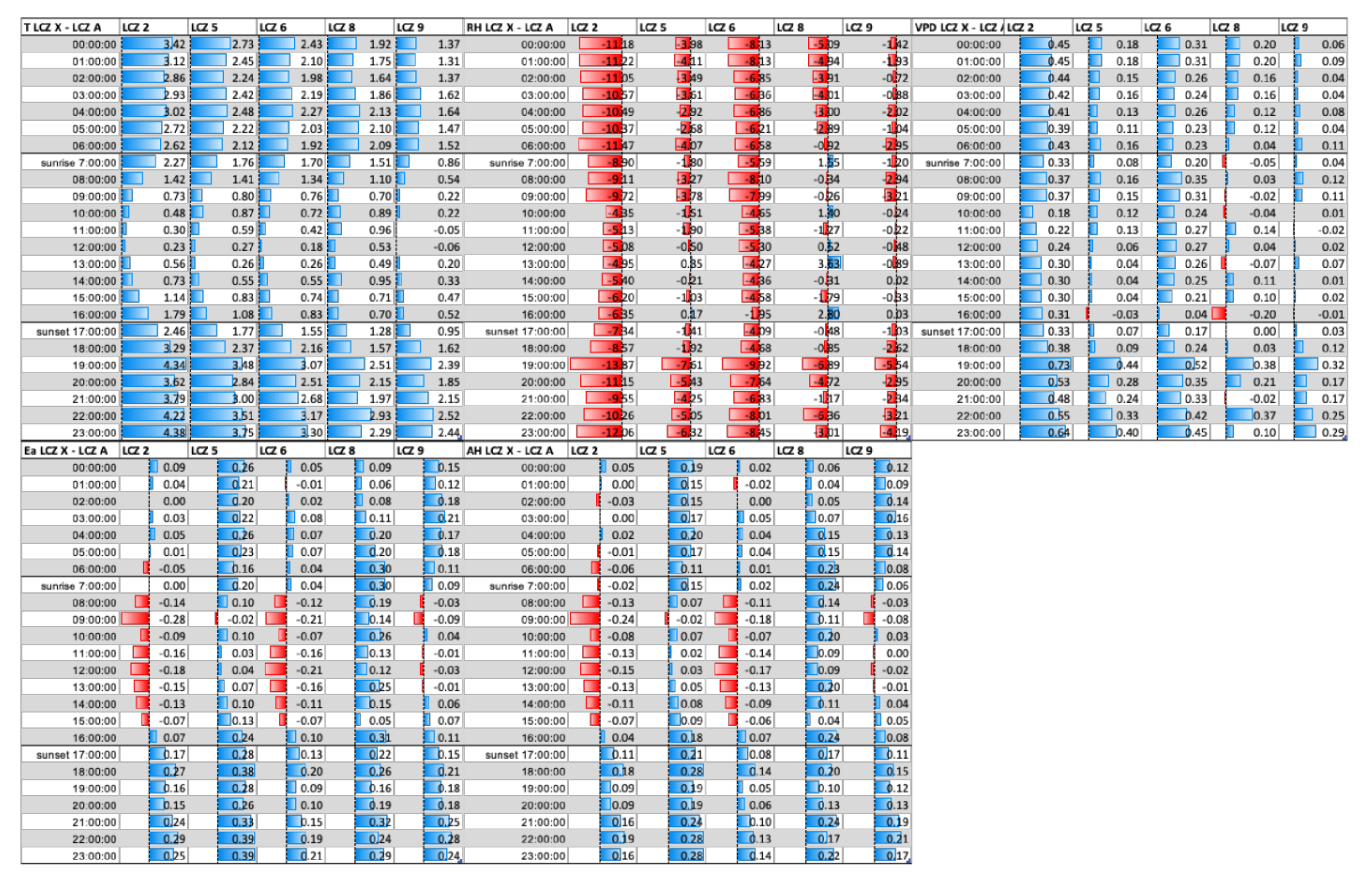
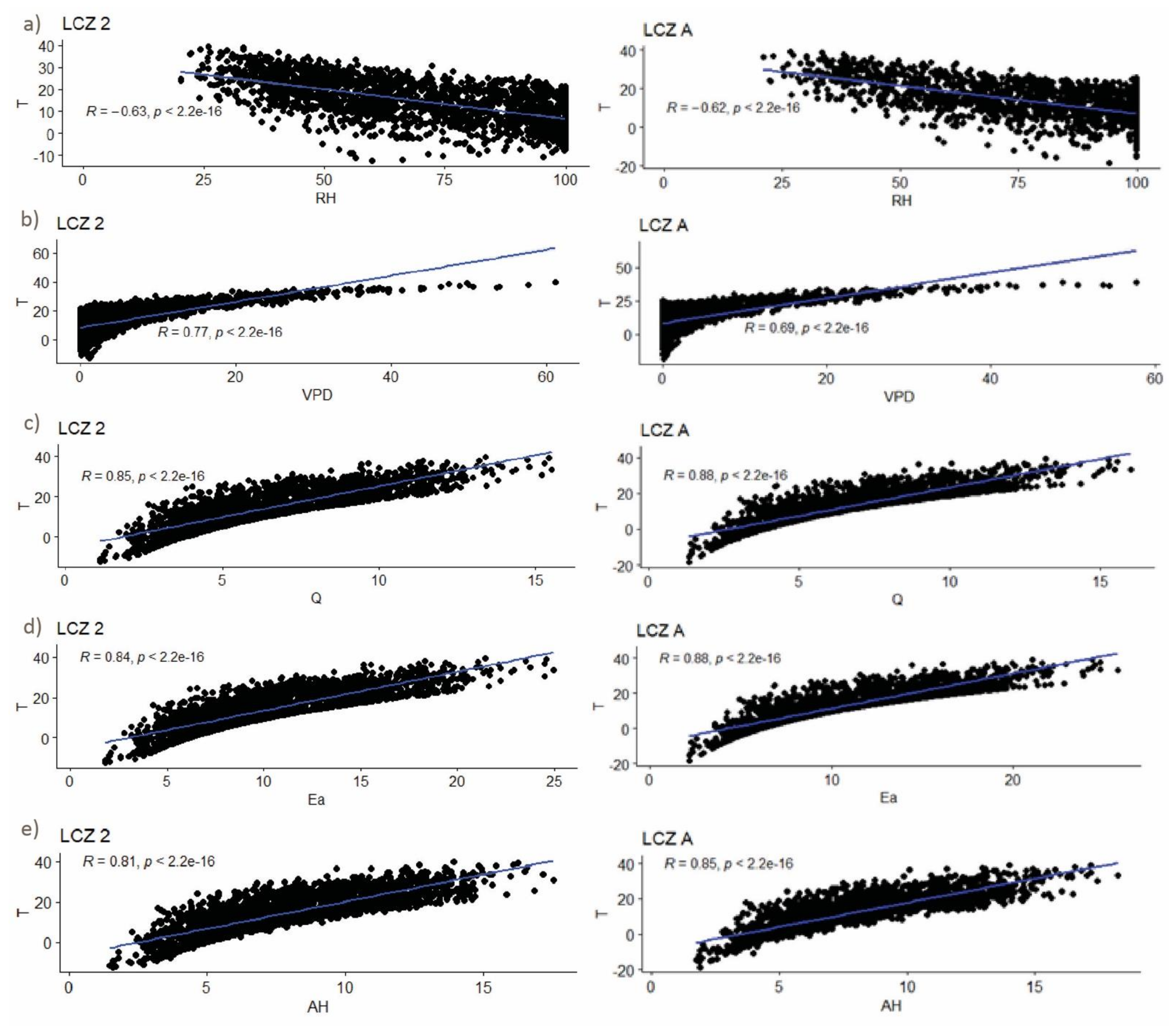
| Parameter | LCZ Class | Max Urban-Natural Difference | Max Intra-Urban Difference | |||||
|---|---|---|---|---|---|---|---|---|
| 2 | 5 | 6 | 8 | 9 | A | ∆LCZ X-LCZ A | ∆LCZ X-LCZ Y | |
| T (°C) | 14.13 | 13.9 | 13.52 | 13.76 | 13.77 | 12.25 | 1.88 LCZ 2-LCZ A | 0.61 LCZ 2-LCZ 6 |
| RH (%) | 72.54 | 78.86 | 78.97 | 78.34 | 77.91 | 82.52 | −9.98 LCZ 2-LCZ A | 6.43 LCZ 6-LCZ 2 |
| VPD (hPa) | 6.17 | 5.03 | 5.08 | 5.42 | 5.47 | 4.01 | 2.16 LCZ 2-LCZ A | 1.14 LCZ 2-LCZ 5 |
| Q (g/kg) | 6.44 | 6.85 | 6.71 | 6.76 | 6.65 | 6.55 | 0.30 LCZ 5-LCZ A | 0.41 LCZ 5-LCZ 2 |
| AH (g/m3) | 7.74 | 8.24 | 8.06 | 8.11 | 8.03 | 7.91 | 0.33 LCZ 5-LCZ A | 0.5 LCZ 5-LCZ 2 |
| Ea (hPa) | 10.37 | 11.04 | 10.78 | 10.85 | 10.74 | 10.54 | 0.5 LCZ 5-LCZ A | 0.67 LCZ 5-LCZ 2 |
Publisher’s Note: MDPI stays neutral with regard to jurisdictional claims in published maps and institutional affiliations. |
© 2021 by the authors. Licensee MDPI, Basel, Switzerland. This article is an open access article distributed under the terms and conditions of the Creative Commons Attribution (CC BY) license (https://creativecommons.org/licenses/by/4.0/).
Share and Cite
Dunjić, J.; Milošević, D.; Kojić, M.; Savić, S.; Lužanin, Z.; Šećerov, I.; Arsenović, D. Air Humidity Characteristics in “Local Climate Zones” of Novi Sad (Serbia) Based on Long-Term Data. ISPRS Int. J. Geo-Inf. 2021, 10, 810. https://doi.org/10.3390/ijgi10120810
Dunjić J, Milošević D, Kojić M, Savić S, Lužanin Z, Šećerov I, Arsenović D. Air Humidity Characteristics in “Local Climate Zones” of Novi Sad (Serbia) Based on Long-Term Data. ISPRS International Journal of Geo-Information. 2021; 10(12):810. https://doi.org/10.3390/ijgi10120810
Chicago/Turabian StyleDunjić, Jelena, Dragan Milošević, Milena Kojić, Stevan Savić, Zorana Lužanin, Ivan Šećerov, and Daniela Arsenović. 2021. "Air Humidity Characteristics in “Local Climate Zones” of Novi Sad (Serbia) Based on Long-Term Data" ISPRS International Journal of Geo-Information 10, no. 12: 810. https://doi.org/10.3390/ijgi10120810
APA StyleDunjić, J., Milošević, D., Kojić, M., Savić, S., Lužanin, Z., Šećerov, I., & Arsenović, D. (2021). Air Humidity Characteristics in “Local Climate Zones” of Novi Sad (Serbia) Based on Long-Term Data. ISPRS International Journal of Geo-Information, 10(12), 810. https://doi.org/10.3390/ijgi10120810








